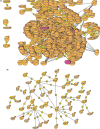MINT, the molecular interaction database: 2009 update
- PMID: 19897547
- PMCID: PMC2808973
- DOI: 10.1093/nar/gkp983
MINT, the molecular interaction database: 2009 update
Abstract
MINT (http://mint.bio.uniroma2.it/mint) is a public repository for molecular interactions reported in peer-reviewed journals. Since its last report, MINT has grown considerably in size and evolved in scope to meet the requirements of its users. The main changes include a more precise definition of the curation policy and the development of an enhanced and user-friendly interface to facilitate the analysis of the ever-growing interaction dataset. MINT has adopted the PSI-MI standards for the annotation and for the representation of molecular interactions and is a member of the IMEx consortium.
Figures



References
-
- Aragues R, Jaeggi D, Oliva B. PIANA: protein interactions and network analysis. Bioinformatics. 2006;22:1015–1057. - PubMed
Publication types
MeSH terms
Substances
Grants and funding
LinkOut - more resources
Full Text Sources
Other Literature Sources

